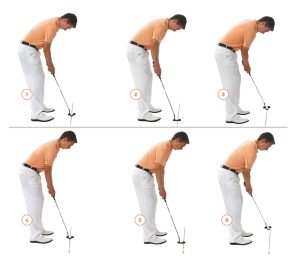How often do you find yourself just a stroke or two away from a better golf score, wishing you could conquer the complexities of putting? Perhaps putting, with its blend of physics, psychology, and finesse, has left you feeling more exasperated than enthusiastic. Understanding the easiest putting technique can be a daunting undertaking; however, it’s an endeavor that promises significant improvements to your golf score and overall gameplay. Reducing your strokes on the green can transform your approach to the game, not by drastic adjustments but rather by embracing a more strategic, informed, and personalized technique.
Understanding the Role of Putting in Golf
Putting is often hailed as the “game within the game,” requiring focus and precision. It uniquely contributes to the complexity of golf, where the objective is not mere distance but rather accuracy. The act of putting bridges the gap between good performance and excellent scores. Mastering it can distinguish between a competent golfer and an extraordinary player.
The Fundamental Importance of Putting
The role of putting highlights its significance on the scorecard. While drives and chip shots get you onto the green, it’s putting that ultimately defines how many strokes it takes to reach the hole. Experts often attribute more than 40% of a golfer’s strokes directly to putting. Thus, efficient putting can drastically reduce your score.
The Psychological Aspect of Putting
Putting isn’t merely mechanical; it is deeply psychological. Maintaining concentration and managing pressure while putting is crucial. The smallest distraction can lead to missed putts. Attaining consistency in putting is about developing mental toughness and confidence, which translates to better performance control on the green.

Mechanics of Putting: The Foundation of the Technique
The putting technique requires a confluence of mechanics, rhythm, and balance. Grasping these fundamentals ensures you have a strong base to develop and adapt your personal style, accommodating conditions and environment.
Grip: The Starting Point
The grip is your first physical interaction with the putter, crucial for control. A well-executed grip stabilizes your putting stroke, offering consistency and comfort.
| Grip Type | Description |
|---|---|
| Reverse Overlap | The index finger of the lead hand rests over the fingers of the trailing hand. This grip offers minimal wrist movement. |
| Claw Grip | Fingers of the trailing hand grip the putter like a claw. It reduces wrist breakdown and caters to improved stability. |
| Cross-Handed | The lead hand is placed below the trailing hand on the putter for better control and direction. |
Stance: A Balanced Approach
A correct stance influences the trajectory and alignment of your putts. Your feet should preferably be shoulder-width apart, balanced, and aligned parallel to the line for the golf ball’s intended path. The stance impacts both your confidence and result.
Alignment and Posture
Keeping your eyes directly over the ball ensures that you’re properly aligned. Your posture should be relaxed yet stable, allowing for a smooth pendulum motion. Setting your elbows close to the ribs reduces unnecessary upper body movement.
Face and Path Control
The face of the putter should remain square to the path throughout the stroke. Consistency in face alignment guarantees the direction and end result remain precise and predictable.
The Putting Stroke: Mastering the Smooth Pendulum
A proper putting stroke resembles a pendulum swing. Synchronization in movement is paramount to ensure predictability and control over the ball’s motion.
Ensuring a Smooth Stroke
A consistent routine involves practicing a smooth, controlled backswing and follow-through. Emphasis should remain on rhythm over force. Controlled strokings, rather than pressing heavily with a forced swing, result in better ball control.
Developing a Pre-shot Routine
Routine builds reliability. A consistent pre-shot routine encourages focus and reduces nervousness. Consider rehearsing your intended line and pace; practice aiming the putter face and stroke with precision.
Reading the Green
Understanding greens is as important as the stroke itself. Terrain, grass, and weather conditions can alter putting decisions significantly.
Analyzing the Terrain
Knowledge of slope and break defines the ball’s path. Practicing reading the slope helps align the ball’s path with the terrain. Capture technical prowess by gauging gradients visually and mentally calculating the impact they might have on your stroke.
Managing Speed and Distance
Speed and distance master the greens. Recognizing green speed and adapting your strokes accordingly ensures ball control and accuracy. Practice putting a variety of distances to improve your speed control.
Psychological Components: Harnessing Your Mental Game
Confidence, focus, and patience are the bedrock of effective putting. Mold your mental approach to foster a positive and detailed outlook on every putt.
Building Confidence
Every stroke made with confidence boosts your self-assurance. Emphasize small victories; each successful hole is motivation for the next.
Overcoming Pressure
Managing pressure translates to a more relaxed demeanor on the green. Visualization aids in applying the perfect amount of pressure to the ball. Regularly engage in mindful practices to stay composed.
Patience and Persistence
Patience emerges as pivotal in the sharpening of your skill set. Preserve poise during setbacks and continue practicing to sustain improvements.
Adapting to Changing Conditions
Weather and course conditions fluctuate, requiring adaptive technique. Flexibility to respond to these challenges lets you maintain consistent performance.
Weather Influences
Environmental elements like wind and rain impact playability. Recognize and adjust your putt’s power and line to accommodate for dragged surfaces or wind gust shifts.
Course Variation
Courses have unique features, evolving due to maintenance, usage, and weather. Each variation necessitates readiness, making rounds on diverse courses invaluable in developing adaptability.
Practice Techniques for Mastery
Practice ensures the ingraining of technique, adaptability, and confidence. Diverse drills promise comprehensive improvement in your putting ability.
Drills and Exercises
Consider drills focused on developing consistent strokes, reading greens, and distance control. Timely repetition of different scenarios stabilizes your muscle memory and mental acuity.
| Drill | Objective |
|---|---|
| Gate Drill | Focus on path control by aiming the putt through a narrow gap; enhances alignment. |
| Distance Ladder | Improve distance control by incrementally increasing the length of your putts. |
| Circle Drill | Place putts from various distances in a circle around the hole, emphasizing consistency. |
Frequency and Consistency
Regular, purposeful practice sustains technique and confidence. Set a structured schedule integrating focused sessions, irrespective of course play or individual sessions.
Common Pitfalls and Corrections
Mistakes offer lessons; identifying them aids improvement. Self-assessing and refining approach shapes effective putting skills.
Common Errors
Recognize typical mistakes like inconsistent strokes or misalignment. Identifying these empowers proactive correction, ensuring future rounds reflect improvements.
Techniques to Correct Mistakes
Adopt techniques to rectify missteps, such as refining grip, stance, or focusing on keeping the putter face square during impact. Engaging in targeted drills can enforce correct habits rapidly.

Integrating Technology and Data
Innovations ensure contemporary advantages in perfecting putting. Embrace available technology to interpret and refine technique.
Using Technology for Improvement
Digital tools analyze putting strokes by examining movement precision and feedback adjustment. Employ apps, sensors, or simulators to enhance technique scientifically.
Analyzing Data
Data offer insights into what contributes to different results. Integrating analytics facilitates understanding and improving performance nuances.
Reflecting on Progress
Self-reflection complements technical practice. Habitual evaluation recognizes growth and areas requiring focus.
Evaluating Outcomes
Tracking performance over time unveils trends and improvements. Careful examination conveys development scope and directs attention to sidelined areas.
Setting Goals
Establishing benchmarks fuels progress. Set tangible goals for both immediate sessions and long-term aspirations, easing adherence to improvement plans.

The Simplicity of the Easiest Technique
Optimizing putting transcends complexities, despite the myriad factors influencing outcomes. Integration of knowledge and practice leads you toward the easiest, most effective technique.
While various elements contribute to efficient putting, recognizing the core fundamentals—personalized grip, stance, mental focus, and adaptability—allows easier mastery. Grasping these elements transforms putting from an elusive skill into an accessible extension of your golfing prowess. Your journey isn’t merely about lowering the score; it encompasses enhancing your golfing philosophy, making each play a rewarding experience.

Ed Baucom is a passionate and dedicated golfer with years of experience both on and off the course. Known for his insightfulness and attention to detail, Ed brings a wealth of knowledge to the golfing community, particularly through his reviews for Golf Aid Advisor. His expertise in evaluating golfing equipment, training aids, and techniques has made him a trusted voice for golfers seeking to improve their game. Whether testing the latest clubs or offering advice on swing mechanics, Ed’s thoughtful and practical assessments help players of all skill levels enhance their performance.

